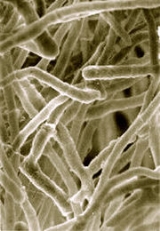
Trichoderma reesei
Encyclopedia
Trichoderma reesei is a mesophilic and filamentous
fungus
. It is an anamorph of the fungus Hypocrea jecorina.
T. reesei has the capacity to secrete large amounts of cellulolytic enzyme
s (cellulase
s and hemicellulases). Microbial cellulase
s have industrial application in the conversion of cellulose
, a major component of plant biomass
, into glucose
.
Recent advances in the biochemistry
of cellulase enzymology, the mechanism of cellulose hydrolysis
(cellulolysis), strain
improvement, molecular cloning and process engineering are bringing T. reesei cellulases closer to being a commercially viable route to cellulose hydrolysis. Several industrially useful strains have been developed and characterised, e.g. Rut-C30, RL-P37 and MCG-80. The genome of this organism was released in 2008. This organism also has a mating type dependent characterised sexual cycle.
Hypha
A hypha is a long, branching filamentous structure of a fungus, and also of unrelated Actinobacteria. In most fungi, hyphae are the main mode of vegetative growth, and are collectively called a mycelium; yeasts are unicellular fungi that do not grow as hyphae.-Structure:A hypha consists of one or...
fungus
Fungus
A fungus is a member of a large group of eukaryotic organisms that includes microorganisms such as yeasts and molds , as well as the more familiar mushrooms. These organisms are classified as a kingdom, Fungi, which is separate from plants, animals, and bacteria...
. It is an anamorph of the fungus Hypocrea jecorina.
T. reesei has the capacity to secrete large amounts of cellulolytic enzyme
Enzyme
Enzymes are proteins that catalyze chemical reactions. In enzymatic reactions, the molecules at the beginning of the process, called substrates, are converted into different molecules, called products. Almost all chemical reactions in a biological cell need enzymes in order to occur at rates...
s (cellulase
Cellulase
400px|thumb|right|alt = Colored dice with checkered background|Ribbon representation of the Streptomyces lividans beta-1,4-endoglucanase catalytic domain - an example from the family 12 glycoside hydrolases...
s and hemicellulases). Microbial cellulase
Cellulase
400px|thumb|right|alt = Colored dice with checkered background|Ribbon representation of the Streptomyces lividans beta-1,4-endoglucanase catalytic domain - an example from the family 12 glycoside hydrolases...
s have industrial application in the conversion of cellulose
Cellulose
Cellulose is an organic compound with the formula , a polysaccharide consisting of a linear chain of several hundred to over ten thousand β linked D-glucose units....
, a major component of plant biomass
Biomass
Biomass, as a renewable energy source, is biological material from living, or recently living organisms. As an energy source, biomass can either be used directly, or converted into other energy products such as biofuel....
, into glucose
Glucose
Glucose is a simple sugar and an important carbohydrate in biology. Cells use it as the primary source of energy and a metabolic intermediate...
.
Recent advances in the biochemistry
Biochemistry
Biochemistry, sometimes called biological chemistry, is the study of chemical processes in living organisms, including, but not limited to, living matter. Biochemistry governs all living organisms and living processes...
of cellulase enzymology, the mechanism of cellulose hydrolysis
Hydrolysis
Hydrolysis is a chemical reaction during which molecules of water are split into hydrogen cations and hydroxide anions in the process of a chemical mechanism. It is the type of reaction that is used to break down certain polymers, especially those made by condensation polymerization...
(cellulolysis), strain
Strain (biology)
In biology, a strain is a low-level taxonomic rank used in three related ways.-Microbiology and virology:A strain is a genetic variant or subtype of a micro-organism . For example, a "flu strain" is a certain biological form of the influenza or "flu" virus...
improvement, molecular cloning and process engineering are bringing T. reesei cellulases closer to being a commercially viable route to cellulose hydrolysis. Several industrially useful strains have been developed and characterised, e.g. Rut-C30, RL-P37 and MCG-80. The genome of this organism was released in 2008. This organism also has a mating type dependent characterised sexual cycle.
See also
- Cellobiohydrolase (CBH)
- Endoglucanase (EG)
- Cellulosic ethanolCellulosic ethanolCellulosic ethanol is a biofuel produced from wood, grasses, or the non-edible parts of plants.It is a type of biofuel produced from lignocellulose, a structural material that comprises much of the mass of plants. Lignocellulose is composed mainly of cellulose, hemicellulose and lignin...
External links
- http://www.eere.energy.gov/cleancities/progs/afdc/vwbs2.cgi?200
- Trichoderma spp.
- from genencor DNA sequence and Trichoderma reesei EST Database and Mitochondrial Genome.
- CBH I from Trichoderma sp..
- CBH I from Trichoderma sp..

